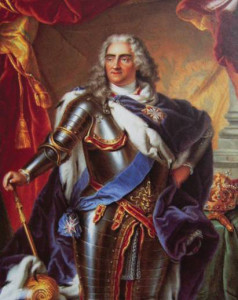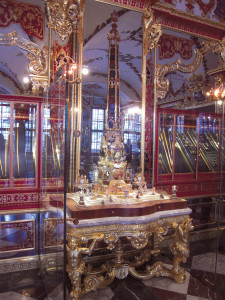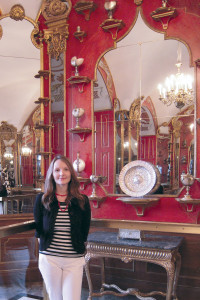The Treasury Chamber of Augustus the Strong and his Vision of a Baroque Gesamtkunstwerk
EMERGING SCHOLARS > SUMMER RESEARCH GRANTS
By Ann Marie Glasscock
Through the generous support of the Decorative Arts Trust, I was able to participate in the Dresden Summer International Academy of the Arts. This intensive program has allowed me to formulate, expand, and confirm several theories in regards to the early eighteenth century treasury chamber of Augustus the Strong of Saxony. Viewing the royal collections in person was certainly a must and has inspired me to follow new and exciting leads that will soon culminate in the completion of my Master’s thesis.
From antiquity, through the Middle Ages, and into the Baroque era, treasuries served as storehouses for the valuable possessions of temples, churches, and the aristocracy. They were sacred, exclusive spaces that were well guarded and secured and accessible only to the owners and select individuals. When Prince Elector Frederick Augustus I (later nicknamed Augustus the Strong) came to power in 1694, he literally transformed the royal treasury of Dresden, colloquially termed the “Green Vault,” from what had historically defined treasuries and created a functional museum space (Figure 1). It would no longer be a secluded intimate area but, quite the contrary, would serve as a public exhibition space in which the collections within the treasury would be displayed.
Such a transformation is one of the many innovative and far-reaching changes which took place in the eighteenth century under Augustus the Strong. His were among the first royal collections to be opened to the public, and they emphasized the wealth and splendor of the state and its ruler. Specifically, the new treasury museum became, in many ways, a statement of power, affluence, and royal self-glorification.
In my research, I propose that Augustus’ political career preceding the reconfiguration of the treasury had a direct impact on this transformation. Augustus was not the successful military leader he had set out to be, but the reorganization of the state collections during the second half of his reign was an impressive achievement which overpowered any failures he had had in the past. In the end, it seems that the King’s ambition for glory was not achieved in military matters but instead was realized within the arrangements of the Green Vault.
In 1721 the comprehensive reorganization of the Green Vault began. Specialized rooms were formed and objects were rearranged in these new interior spaces. Of the eight carefully staged exhibition rooms, the last gallery in the concourse, the Jewel Room (Juwelenzimmer), was a magnificent manifestation of the fact that the Green Vault served Augustus as a tool to demonstrate that it was more than a place where beauty was displayed and worshipped; it was also a place where he could demonstrate his royal power and wealth (Figure 2).1 In this luxurious exhibition space were several masterpieces by the court jeweler, and the King’s favorite goldsmith, Johann Melchior Dinglinger. Of these cabinet pieces, the Obeliscus Augustalis was one of several objects of self-fashioning that personified the King’s power and affluence (Figure 3).
Foremost, at the base of the obelisk, a crowned portrait of Augustus is literally placed on the same level as Gaius Maecenas, the political advisor to the ancient Roman Emperor Octavian, soon to become known as Emperor Augustus (Figures 4 and 5). Thus Augustus the Strong has emphasized the visual link between himself and his ancient namesake and metaphorically become the “Emperor” with his confidant at his side. I am in agreement with the scholar Barbara Marx that the placement of these two important figures “may have supplemented, in artistic terms, the king’s frustrated desire for self-glorification.” 2 This position also appears to represent his longing for “imperial” rule.
Furthermore, the obelisk itself raises Augustus to a state of power in regards to the structure’s historical meaning. To the Egyptians, the obelisk was a symbol of the pharaoh’s right to rule and his connection to the divine. In ancient Rome, the obelisk was an embodiment of Rome’s coming of age as an Empire.3 Did the obelisk therefore symbolize Augustus’ desire of his own “coming of age” as a ruler with far-reaching powers? Overall, the Obeliscus Augustalis essentially personified and objectified the Caesarean dreams of the Saxon-Polish monarch.
While one could be further indulged in the significance of the Obeliscus Augustalis, I must conclude this interesting study. As such, the overall restructuring of the treasury was an impressive achievement in thought and organization. Augustus took what was once chaotic and imposed on it a system of symmetry and hierarchies and a sense of order. Augustus would not win the military and political battles he had fought, but he had won over the minds of the people and created a space which emanated not only his own royal self-glorification but also that of the city of Dresden. Augustus the Strong had successfully created his vision of a Gesamtkunstwerk or total work of art.
In conclusion, Ann would like to thank the members of the Decorative Arts Trust for their enthusiasm and support. She is more than happy to discuss her ongoing research and may be reached atann.glasscock@temple.edu.
Footnotes:
1 Dirk Syndram, “The Green Vault: From National Vault to Treasury Museum,” in The Glory of Baroque Dresden: The State Art Collections Dresden (Jackson: Mississippi Commission for International Cultural Exchange, 2004), 150.
2 Barbara Marx, “From Protestant Fortress to Baroque Apotheosis: Dresden from the Sixteenth to the Eighteenth Century,” in Embodiments of Power: Building Baroque Cities in Europe, eds. by Gary B. Cohen and Franz A.J. Szabo (New York: Berghahn Books, 2008), 143.
3 Brian A. Curran, Anthony Grafton, Pamela O. Long, and Benjamin Weiss, introduction to Obelisk: A History (Cambridge: MIT Press, 2009), 8.
SAVE THE DATE
- Special Symposium
“Classical Splendor”
The Philadelphia Museum of Art
November 4, 2016 - New York Antiques Weekend
January 20-21, 2017 - Spring Symposium
Savannah
April 21-24, 2017 - Spring Study Trip Abroad
Scotland
May 14-22, 2017 - Fall Symposium
Hartford & Western Connecticut
September 2017 - Fall Study Trip Abroad
Venice and the Veneto
October 9-16 and 22-29, 2017
By Ann Marie Glasscock
Through the generous support of the Decorative Arts Trust, I was able to participate in the Dresden Summer International Academy of the Arts. This intensive program has allowed me to formulate, expand, and confirm several theories in regards to the early eighteenth century treasury chamber of Augustus the Strong of Saxony. Viewing the royal collections in person was certainly a must and has inspired me to follow new and exciting leads that will soon culminate in the completion of my Master’s thesis.
From antiquity, through the Middle Ages, and into the Baroque era, treasuries served as storehouses for the valuable possessions of temples, churches, and the aristocracy. They were sacred, exclusive spaces that were well guarded and secured and accessible only to the owners and select individuals. When Prince Elector Frederick Augustus I (later nicknamed Augustus the Strong) came to power in 1694, he literally transformed the royal treasury of Dresden, colloquially termed the “Green Vault,” from what had historically defined treasuries and created a functional museum space (Figure 1). It would no longer be a secluded intimate area but, quite the contrary, would serve as a public exhibition space in which the collections within the treasury would be displayed.
Such a transformation is one of the many innovative and far-reaching changes which took place in the eighteenth century under Augustus the Strong. His were among the first royal collections to be opened to the public, and they emphasized the wealth and splendor of the state and its ruler. Specifically, the new treasury museum became, in many ways, a statement of power, affluence, and royal self-glorification.
In my research, I propose that Augustus’ political career preceding the reconfiguration of the treasury had a direct impact on this transformation. Augustus was not the successful military leader he had set out to be, but the reorganization of the state collections during the second half of his reign was an impressive achievement which overpowered any failures he had had in the past. In the end, it seems that the King’s ambition for glory was not achieved in military matters but instead was realized within the arrangements of the Green Vault.
In 1721 the comprehensive reorganization of the Green Vault began. Specialized rooms were formed and objects were rearranged in these new interior spaces. Of the eight carefully staged exhibition rooms, the last gallery in the concourse, the Jewel Room (Juwelenzimmer), was a magnificent manifestation of the fact that the Green Vault served Augustus as a tool to demonstrate that it was more than a place where beauty was displayed and worshipped; it was also a place where he could demonstrate his royal power and wealth (Figure 2).1 In this luxurious exhibition space were several masterpieces by the court jeweler, and the King’s favorite goldsmith, Johann Melchior Dinglinger. Of these cabinet pieces, the Obeliscus Augustalis was one of several objects of self-fashioning that personified the King’s power and affluence (Figure 3).
Foremost, at the base of the obelisk, a crowned portrait of Augustus is literally placed on the same level as Gaius Maecenas, the political advisor to the ancient Roman Emperor Octavian, soon to become known as Emperor Augustus (Figures 4 and 5). Thus Augustus the Strong has emphasized the visual link between himself and his ancient namesake and metaphorically become the “Emperor” with his confidant at his side. I am in agreement with the scholar Barbara Marx that the placement of these two important figures “may have supplemented, in artistic terms, the king’s frustrated desire for self-glorification.” 2 This position also appears to represent his longing for “imperial” rule.
Furthermore, the obelisk itself raises Augustus to a state of power in regards to the structure’s historical meaning. To the Egyptians, the obelisk was a symbol of the pharaoh’s right to rule and his connection to the divine. In ancient Rome, the obelisk was an embodiment of Rome’s coming of age as an Empire.3 Did the obelisk therefore symbolize Augustus’ desire of his own “coming of age” as a ruler with far-reaching powers? Overall, the Obeliscus Augustalis essentially personified and objectified the Caesarean dreams of the Saxon-Polish monarch.
While one could be further indulged in the significance of the Obeliscus Augustalis, I must conclude this interesting study. As such, the overall restructuring of the treasury was an impressive achievement in thought and organization. Augustus took what was once chaotic and imposed on it a system of symmetry and hierarchies and a sense of order. Augustus would not win the military and political battles he had fought, but he had won over the minds of the people and created a space which emanated not only his own royal self-glorification but also that of the city of Dresden. Augustus the Strong had successfully created his vision of a Gesamtkunstwerk or total work of art.
In conclusion, Ann would like to thank the members of the Decorative Arts Trust for their enthusiasm and support. She is more than happy to discuss her ongoing research and may be reached atann.glasscock@temple.edu.
Footnotes:
1 Dirk Syndram, “The Green Vault: From National Vault to Treasury Museum,” in The Glory of Baroque Dresden: The State Art Collections Dresden (Jackson: Mississippi Commission for International Cultural Exchange, 2004), 150.
2 Barbara Marx, “From Protestant Fortress to Baroque Apotheosis: Dresden from the Sixteenth to the Eighteenth Century,” in Embodiments of Power: Building Baroque Cities in Europe, eds. by Gary B. Cohen and Franz A.J. Szabo (New York: Berghahn Books, 2008), 143.
3 Brian A. Curran, Anthony Grafton, Pamela O. Long, and Benjamin Weiss, introduction to Obelisk: A History (Cambridge: MIT Press, 2009), 8.






